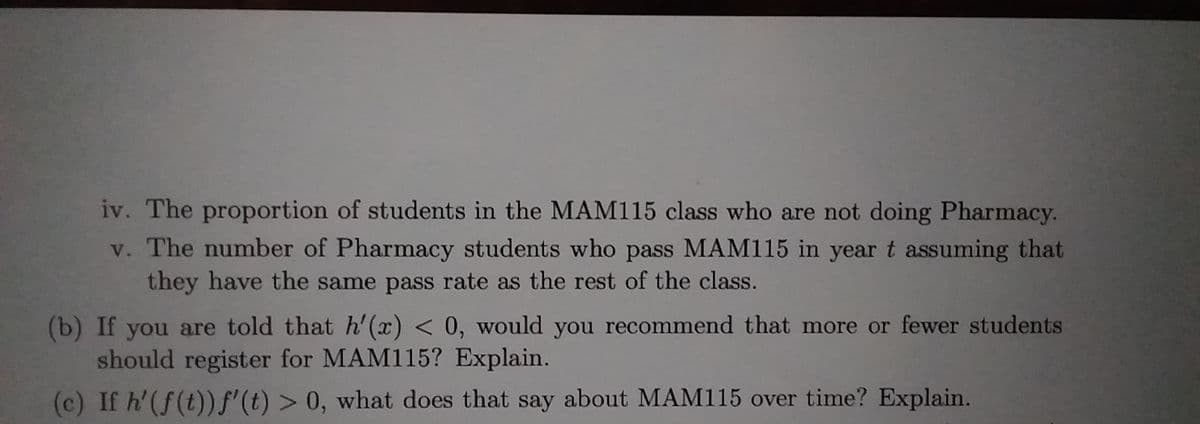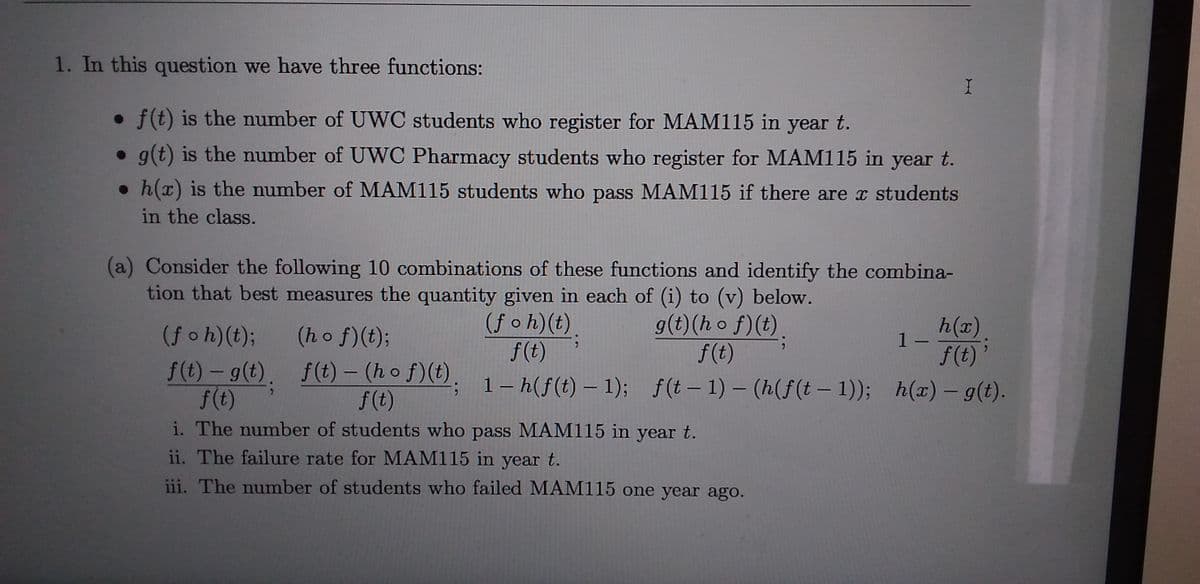1. In this question we have three functions: • f(t) is the number of UWC students who register for MAM115 in year t. • g(t) is the number of UWC Pharmacy students who register for MAM115 in year t. h(x) is the number of MAM115 students who pass MAM115 if there are r students in the class. (a) Consider the following 10 combinations of these functions and identify the combina- tion that best measures the quantity given in each of (i) to (v) below. (foh)(t). f(t) f(t) – g(t). f(t) – (h o f)(t). 1- h(f(t) – 1); f(t - 1) – (h(f(t – 1)); h(x) – g(t). g(t)(h o f)(t). f(t) h(x). f(t) (foh)(t); (ho f)(t); 1- f(t) f(t) i. The number of students who pass MAM115 in year t. ii. The failure rate for MAM115 in year t. iii. The number of students who failed MAM115 one year ago.
1. In this question we have three functions: • f(t) is the number of UWC students who register for MAM115 in year t. • g(t) is the number of UWC Pharmacy students who register for MAM115 in year t. h(x) is the number of MAM115 students who pass MAM115 if there are r students in the class. (a) Consider the following 10 combinations of these functions and identify the combina- tion that best measures the quantity given in each of (i) to (v) below. (foh)(t). f(t) f(t) – g(t). f(t) – (h o f)(t). 1- h(f(t) – 1); f(t - 1) – (h(f(t – 1)); h(x) – g(t). g(t)(h o f)(t). f(t) h(x). f(t) (foh)(t); (ho f)(t); 1- f(t) f(t) i. The number of students who pass MAM115 in year t. ii. The failure rate for MAM115 in year t. iii. The number of students who failed MAM115 one year ago.
Algebra & Trigonometry with Analytic Geometry
13th Edition
ISBN:9781133382119
Author:Swokowski
Publisher:Swokowski
Chapter3: Functions And Graphs
Section3.5: Graphs Of Functions
Problem 52E
Related questions
Question

Transcribed Image Text:iv. The proportion of students in the MAM115 class who are not doing Pharmacy.
v. The number of Pharmacy students who pass MAM115 in year t assuming that
they have the same pass rate as the rest of the class.
(b) If you are told that h'(x) < 0, would you recommend that more or fewer students
should register for MAM115? Explain.
(c) If h'(f(t))f'(t) > 0, what does that say about MAM115 over time? Explain.

Transcribed Image Text:1. In this question we have three functions:
• f(t) is the number of UWC students who register for MAM115 in year t.
• g(t) is the number of UWC Pharmacy students who register for MAM115 in year t.
• h(x) is the number of MAM115 students who pass MAM115 if there are x students
in the class.
(a) Consider the following 10 combinations of these functions and identify the combina-
tion that best measures the quantity given in each of (i) to (v) below.
h(x).
f(t)'
; 1- h(f(t) – 1); f(t – 1) – (h(f(t – 1)); h(x) – g(t).
(foh)(t),
f(t)
g(t)(h o f)(t)
f(t)
(f oh)(t); (ho f)(t);
-
f(t) – g(t),
f(t)
i. The number of students who pass MAM115 in year t.
f(t) – (h o f)(t).
f(t)
|
ii. The failure rate for MAM115 in year t.
iii. The number of students who failed MAM115 one year ago.
Expert Solution
This question has been solved!
Explore an expertly crafted, step-by-step solution for a thorough understanding of key concepts.
This is a popular solution!
Trending now
This is a popular solution!
Step by step
Solved in 5 steps

Knowledge Booster
Learn more about
Need a deep-dive on the concept behind this application? Look no further. Learn more about this topic, advanced-math and related others by exploring similar questions and additional content below.Recommended textbooks for you

Algebra & Trigonometry with Analytic Geometry
Algebra
ISBN:
9781133382119
Author:
Swokowski
Publisher:
Cengage

Algebra: Structure And Method, Book 1
Algebra
ISBN:
9780395977224
Author:
Richard G. Brown, Mary P. Dolciani, Robert H. Sorgenfrey, William L. Cole
Publisher:
McDougal Littell

Algebra & Trigonometry with Analytic Geometry
Algebra
ISBN:
9781133382119
Author:
Swokowski
Publisher:
Cengage

Algebra: Structure And Method, Book 1
Algebra
ISBN:
9780395977224
Author:
Richard G. Brown, Mary P. Dolciani, Robert H. Sorgenfrey, William L. Cole
Publisher:
McDougal Littell